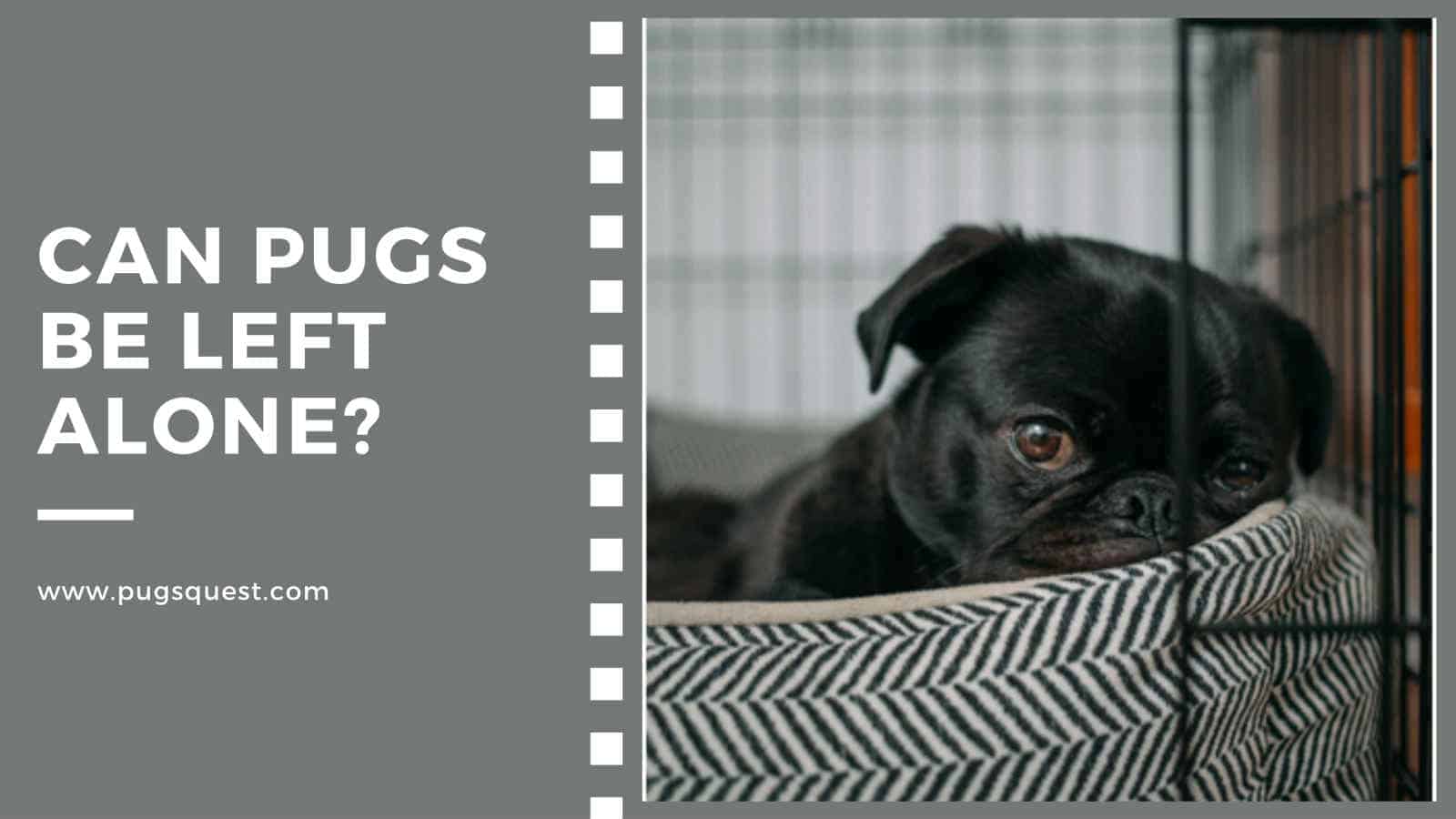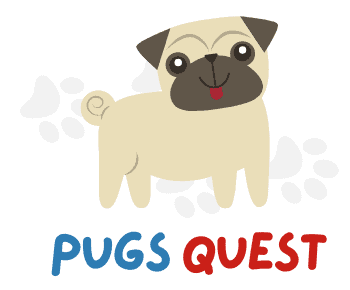
That’s a great question.
With our busy schedules, it’s inevitable that our pets will be alone sometimes.
But it can be hard to know when time alone becomes too much. Sid loves to be around me all the time, luckily Charley could be a perfect companion when we are not alongside.
Every dog is different. As responsible dog owners, it’s important that we do what’s best for them.
In this article, we’re talking about all things Pug. We’ll ask how long it’s okay to leave your little pal at home, and how to make them as comfortable as possible.
Can Pugs Be Left Alone?
The short answer is, yes. Pugs can be left alone – for a bit. However, that doesn’t mean they can be left alone for hours upon hours at a time.
Pugs, in particular, are a breed that needs human companionship. They were bred for it. These little fellas live for quality time with their owners. This is what makes them feel safe and calm.
But like all pets, Pugs will have to get used to spending some time alone. Whether it’s because you’ve got to go out to work or nip out to run errands it’s impossible to give your Pug 24/7 attention 365 days a year.
Puppies need to be trained from a young age to get used to some alone time. Not only is it easier for you as an owner when you have to go out, but it means your dog will remain relaxed at home even when you’re gone. And that’s important for preventing undue anxiety.
But how long is too long?
How Long Can I Leave My Pug Alone? Puppies vs. Adult Pugs
There’s no one-size-fits-all answer to this one. How long you can leave your Pug at home alone will depend on a number of factors.
- Age of your Pug
- Level of training
- Temperament
- Anxiety levels
The PSDA recommends leaving your Pug for no longer than 4 hours at a time.
But that’s not always possible if you’ve got a full-time job.
When it comes to deciding how long you’re comfortable leaving your Pug at home, it’s important to use your own discretion. The opinion is widely divided on this topic.
Some recommend no more than 4-6 hours tops. Others say a fully house-trained Pug in good health can be left alone for between 8-10 hours per day without any problems.
For most people with an average working routine that makes it more or less possible to have a Pug whilst holding down full-time employment.
One of the most important factors to bear in mind is your Pug’s age.
Puppies, for example, cannot be left alone for long periods of time. Not least because they don’t gain full control of their bowel movements until at least 5 or 6 months of age.
A Pug puppy should never be left alone for more than 4 hours at a time. In fact, younger pups between 8 and 10 weeks old shouldn’t be left alone any longer than an hour.
Not only will they become scared and restless, but they’ll probably pee all over the carpet as well.
For this reason, it’s essential to start potty training your Pug pup early – especially if you plan to be out of the house on a regular basis.
Check out this video all about how to potty train your Pug puppy:
Summary:
- 8-10 weeks – never leave for more than 1 hour
- 2-3 months – never leave for more than 2 hours
- 4 + months – try not to leave for more than 4 hours
- 18 + months (adult Pug) – between 6 and 8 hours depending on your dog
When Nobody’s Home Pugs… Do What?
You might be wondering what your Pug gets up to whilst your gone. Your Pug’s solo activities will vary depending on their personality and anxiety levels.
But usually, they’re doing one of the following.
1. Sleeping
Pugs are big sleepers as it is. Adult Pugs are known to nap up to 16 hours a day. And pups even more. So chances are your Pug is snoozing away whilst you’re working hard at the office.
2. Eating
We all know how much Pugs love to eat. There’s a good chance your Pug will gobble up their dinner in a jiff as soon as you step out the door. More nervous animals might not eat at all, however. This could be a sign of separation anxiety.
3. Playing
After that much-needed snooze, your Pug will probably try to entertain themselves with some playtime – especially if you leave lots of fun toys for them to while away the hours.
4. Guarding the home
Some Pugs fancy themselves as quite the guard dogs (despite their less than menacing size). Unless you baby-gate them into one room whilst you’re out, chances are your Pug is patrolling the kingdom and exploring every room.
Top-tip: If your Pug has free reign of the house whilst you’re out, make sure any hazards are removed or kept securely locked away and out of reach.
5. Speaking
This is one to look out for. If your Pug is whining, crying, growling, or barking a lot whilst you’re out of the home, it could be an indication of separation anxiety. Your Pug is in distress and it’s important to start treating this behavior with training as soon as possible. We recommend talking to your vet or an animal behaviorist.
Top-tip: If you think your Pug falls into this category but you’re not sure, try recording them whilst you’re out one day.
What Are The Risks? Pugs And Separation Anxiety
Whilst most Pugs will be just fine on their own for a few hours a day, some might find it a bit harder to deal with. Some Pugs will develop separation anxiety if left alone for long periods of time. And that’s no laughing matter.
Separation anxiety isn’t the same thing as loneliness. And not all Pugs will be able to tolerate 8 + hours a day alone. Pugs suffering from this kind of anxiety are in psychological distress.
This behavioral disorder is more common in Pugs than in some other breeds. That’s because Pugs were bred for companionship. It’s in their DNA.
1. Signs and symptoms
Any of these behaviors (in excess) could be an indication that your Pug is suffering from separation anxiety.
- Barking and chewing
- Licking or pacing
- Whining or crying
- Elimination
- Depressed mood
- Panicking when you leave
2. How to help
There are a number of things you can do to help alleviate your Pug’s separation anxiety. However, in extreme cases, you may need the help of a qualified animal behaviorist.
Things you can do at home include:
- Minimizing time spent alone
- Providing toys and chews
- Create a ‘safe space’
- Tire them out with exercise
How To Make Things Easier On Your Pug
Everyone has to leave the house so it’s essential that we find ways to make life easier for us and our Pugs during these times.
We’re going to take a look at two approaches.
- Limit the amount of time your Pug is left alone
- Improve the quality of alone time for your Pug
The best approach is a combination of these two options. Depending on your lifestyle and commitments, any combination of these great options could be perfect for you.
Let’s delve in.
1. Limit the amount of time your Pug is left alone
As much as possible, try to limit the amount of time your Pug spends alone.
Now that’s not to say you should be a prisoner in your own home. Rather, with a bit of planning, there are ways to have the best of both worlds.
Take a look at some of these great options.
- Dog walking services
Hiring a dog walker a few times a week is a great way to get your Pug out and about and in good company whilst you’re away at work.
- Doggie daycare
Doggie daycare is quite the norm these days. If you can afford to send your Pug to a daycare service (even if it’s just once or twice a week) this is a great way to help them feel less lonely. Plus they’ll get to play with other dogs.
- Flex-work
See if your workplace offers flexible working arrangements. These days, this is becoming more and more common.
Perhaps you can work from home a few days a week, or even take your Pug into the office with you – your colleagues will love you.
- Get a car seat
Getting your car equipped for a doggie passenger is a super way to reduce the amount of time your Pug spends alone.
This way your Pug can join you as you go out and about completing errands or visiting friends and family.
- Friends and family
Speaking of friends and family. If you’ve got a trusted friend, neighbor, or family member nearby why not ask them to check in on your Pug from time to time. They might be able to take them for a walk or play with them for a while.
- More pets
If you’re in a position to get another pet, this can do wonders for your Pug’s loneliness. They’ll have someone to play with at all times whilst you’re away.
2. Improve The Quality of Alone Time For Your Pug
As well as making sure your Pug has as much company on a regular basis as possible, you can also try to improve the quality of their alone time as much as possible. That way time alone will be safer, and tons more fun.
Why not try out some of these options with your own Pug.
- Make your home Pug-safe
Make sure your home is safe by blocking access to any potential hazards. Limit your Pug’s access to cluttered rooms or stairs with baby gates and make sure toxic substances and breakable items are out of reach.
- Train your Pug
Instead of leaving your Pug alone all at once, train them into it gradually.
Start by leaving them alone for very short periods and then build up incrementally. This process can be started at any age, but for best results start early.
- Don’t make a fuss
Try not to make too much of a fuss when you leave the house. This will just increase your Pug’s anxiety. Instead, it’s best to play it cool.
Settle your Pug into their ‘safe zone’ or favorite room with a fun toy and make sure there’s enough food and water for the day.
As tempted as you are to smother your Pug in goodbye kisses – resit.
- Provide lots of distraction
If your Pug has lots of entertaining toys to play with whilst you’re out, chances are they won’t even notice the hours pass.
Loneliness is often just a byproduct of boredom and lack of mental stimulation. And that’s so easy to fix.
Get your Pug some super fun toys and chews to help them while away the hours in glee.
Make Pug Loneliness A Thing of The Past
Though most Pugs will be perfectly fine spending a few hours alone each day, all Pugs are different.
Can Pugs be left alone?
Yes. Within reason.
But it’s up to us as responsible Pug owners to decide how many hours is suitable for our pets.
Photo by Charles Deluvio on Unsplash
